What Is The Cuticle Of The Hair? Signs Of Damage & Repair
Shiny, healthy hair is everyone’s dream, but achieving it requires more than just hair care products. You must learn to care for your hair cuticles. The hair cuticle is responsible for how hair feels and looks.
The hair cuticle, the outermost layer of your hair strand, acts as an invisible protective covering. It consists of many colorless, dead cells that keep your hair secure and healthy.
In this blog, you will learn about the structure of hair cuticles, their types and functions and the difference between healthy and unhealthy cuticles.
What Is the Cuticle of the Hair?
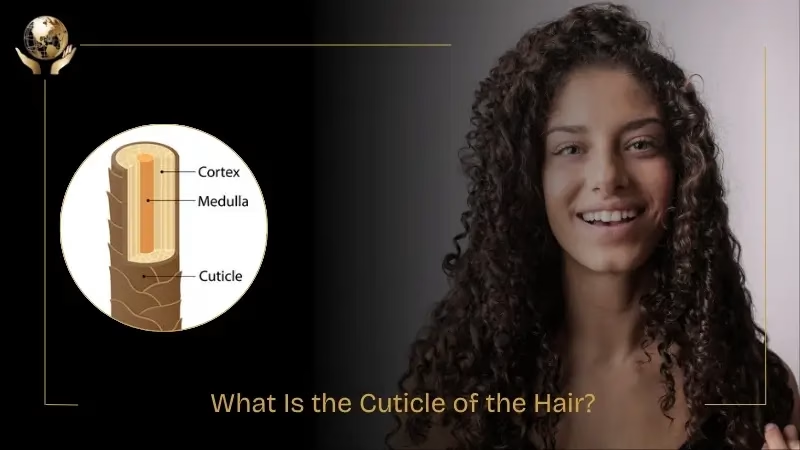
The cuticle layer acts like a tough outer shell that safeguards everything inside it. It is made of multiple layers of flattened dead cells that sit on each other like roof shingles or the fish scales.
These tiny, colorless cells lie flat and give your hair a shiny, glossy appearance. When damaged or raised, they make your hair feel rough and tangled.
Hair Cuticle Structure
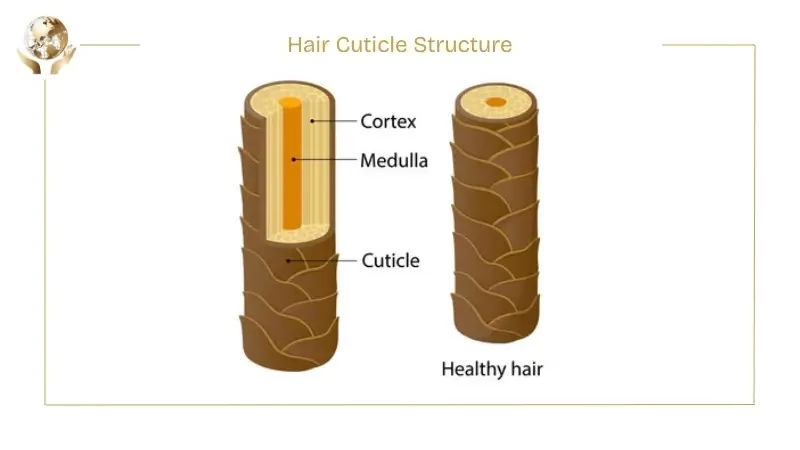
The layers of hair cuticles that are arranged in the form of scales are composed of keratin which gives strength to your hair strands.
Thickness Variations By Hair Type
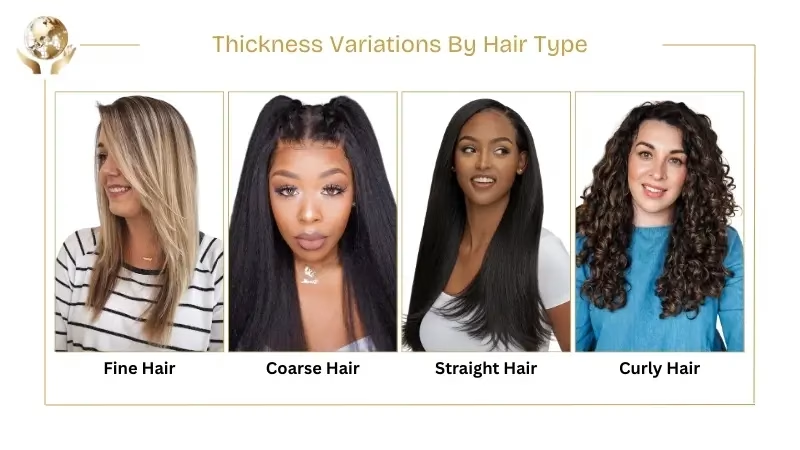
Hair thickness varies among individuals, it depends on how healthy your hair is and how many layers of cuticles are protecting it.
| Hair Type | Cuticle Layers | Common Issues |
| Fine Hair | Fewer cuticle layers (6-7) | More prone to damage |
| Coarse Hair | More cuticle layers (8-10) | Can be harder to penetrate with products |
| Straight Hair | Scales lie flatter | Generally smoother appearance |
| Curly Hair | More raised scales at curves | Higher porosity, more prone to dryness |
Connection to Inner Layers
Your hair strand is made of three layers and the cuticle layer of hair wraps around two inner layers:
- Cortex Layer Of Hair: Contains proteins and determines hair strength and color.
- Medulla Hair: The innermost core (not present in fine hair).
What Are The Different Types Of Cuticle Patterns In Hair?
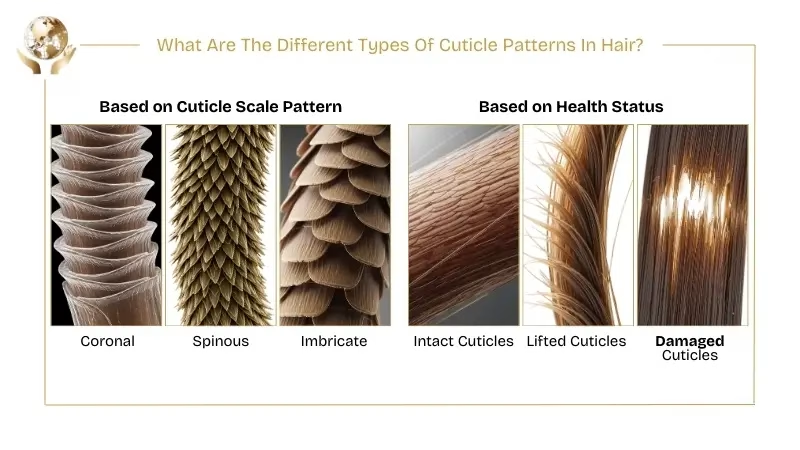
Hair cuticles are of multiple types based on their scale pattern and health status.
Based on Cuticle Scale Pattern
- Coronal: Ring-like scales (found in very fine hair)
- Spinous: Petal-like scales (found in some hair type)
- Imbricate: Flattened scales that overlap (typical of coarse hair)
Based on Health Status
- Intact Cuticles: Smooth, flat scales
- Lifted Cuticles: Slightly raised scales
- Damaged Cuticles: Broken, missing, or severely lifted scales
What Is The Function Of The Cuticle In Hair

Your hair cuticle has multiple important functions which is why it is important to take good care of it. Some key functions are:
- Protection: It keeps the other two layers, cortex and medulla safe from harm.
- Moisture Regulation: It controls the amount of water content that enters into hair strands.
- Shine Factor: Healthy and closed cuticles are smooth, they reflect light and add natural shine to your hair.
- Strength: Cells of the cuticle are made of protein and they provide strength to the hair.
What Does a Healthy Hair Cuticle Look Like?
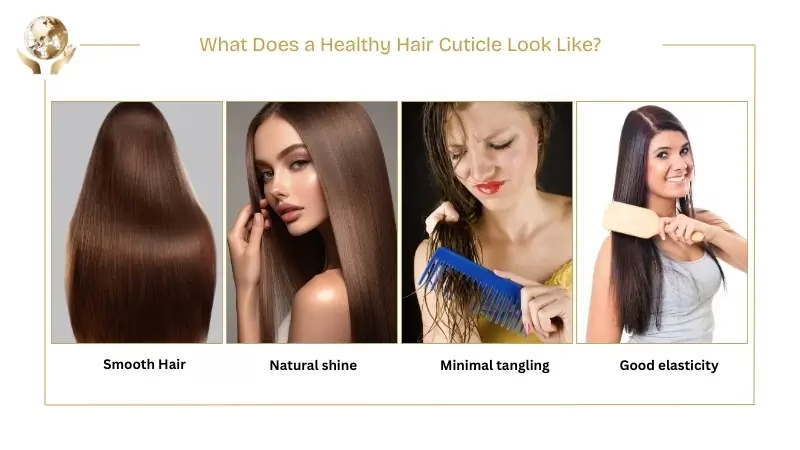
Healthy hair cuticles are smooth and flat forming a uniform and tight layer. This prevents excessive moisture from entering and leaving your hair strands and thus, keeping the hair healthy.
Here are some distinct features of a healthy cuticle:
- Scales lie flat and smooth
- Hair feels soft to the touch
- Natural shine without products
- Minimal tangling
- Even texture from root to tip
- Good elasticity when wet
- Color looks vibrant and even
Healthy vs Unhealthy Cuticle – Key Differences

Your hair health depends on its cuticles. If the hair cuticle is damaged or open, your hair will be rough, frizzy and lack strength.
| Feature | Healthy Cuticle | Unhealthy Cuticle |
| Appearance | Smooth, shiny and reflect light | Rough, dull, lack shine |
| Texture | Soft, silky feel | Rough, straw-like texture |
| Tangling | Minimal tangles | Frequent tangles and knots |
| Porosity | Balanced moisture absorption | Either too porous or resistant |
| Elasticity | Stretches and returns when wet | Breaks easily or won’t stretch |
| Color retention | Even, vibrant color | Faded, uneven color |
What Causes Damaged Cuticles In Hair?
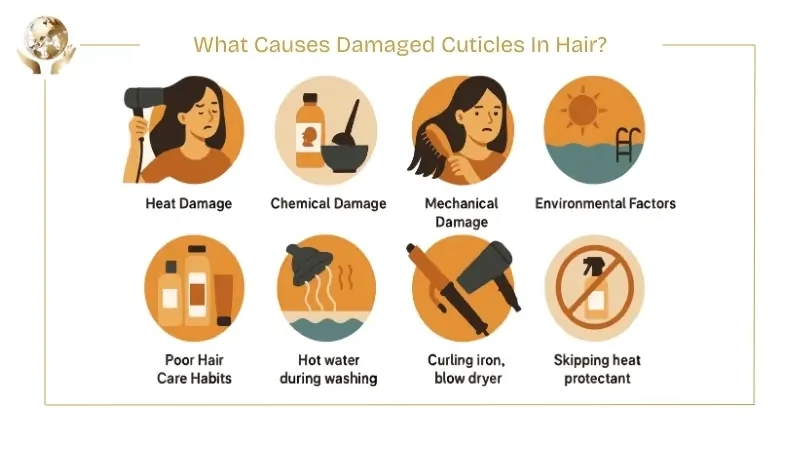
You can damage the hair cuticle during daily life activities, it is important to understand its causes.
Heat Damage
- Hot water during washing
- Excessive sun exposure
- Curling iron, blow dryer
Chemical Damage
- Hair dyes and bleaching (especially relevant for how to close hair cuticle after bleaching)
- Perms and relaxers
- Harsh sulfates in shampoos
Mechanical Damage
- Aggressive brushing when wet
- Tight hairstyles
- Rough towel drying
Environmental Factors
- Radiation
- Chlorine in swimming pool water.
- Pollution and free radicals
Poor Hair Care Habits
- Skipping heat protectant
- Using wrong products for your hair type
- Infrequent deep conditioning
- Prolonged use of hair dryer
How To Have Healthy Hair Cuticles?
Prevention is way better than trying to fix damage later. Here’s how to seal hair cuticle and keep it healthy:
- Do not use very hot water for hair wash, this can open the hair cuticles.
- Use silk pillowcases for sleeping as they prevent hair from tangling.
- Always apply a heat protectant serum before styling to prevent the damage.
- Use a wooden wide-tooth comb in wet hair to detangle your hair easily.
- Do not use harsh chemicals on your hair frequently, they are harmful for hair cuticles.
- Pat hair dry instead of rubbing with a harsh towel.
- Take a healthy diet full of nutrients for hair health.
- Use a hat or any protecting serum outside to prevent hair from sun rays damage.
Can You Open/Close a Hair Cuticle?

An open hair cuticle is the first sign of damage, which could lead to breakage. There are several causes that opens a hair cuticle:
- Heat (hot water, styling tools)
- High pH products (some shampoos)
- Chemical treatments (bleach, dye)
- Moisture (humidity, wet conditions)
Once a hair cuticle is open, you cannot permanently close it. The only option is to follow a proper hair care routine which makes the hair cuticle smooth and prevents further damage. You can temporary close hair cuticle with the help of:
- Cool water rinses
- Low pH products (acidic treatments)
- Proper conditioning
- Cool air from blow dryer
What Is Hair Porosity?

Hair porosity means how much water your hair can absorb and release. It depends upon the cuticle of your hair.
| Porosity Level | Cuticle Condition | Outcome |
| Low Porosity | Tightly closed cuticles | Hard to wet, products sit on surface |
| Normal Porosity | Slightly raised cuticles | Balanced moisture absorption |
| High Porosity | Very raised or open cuticle | Absorbs moisture quickly but loses it fast |
How To Tell If A Cuticle Is Damaged?
You can notice these signs of damaged hair cuticle:
Physical Signs
- Rough, straw-like texture
- Excessive tangling
- Split ends and breakage
- Lack of shine or dullness
- Frizz that won’t smooth down
- Hair that feels dry despite conditioning
Styling & Maintenance Issues
- Color fades quickly
- Products don’t seem to work
- Hair takes forever to dry or dries too quickly
- Difficulty styling or holding styles
How To Repair a Damaged Hair Cuticle

If your cuticle is damaged, you can follow treatments at home and in the salon for hair cuticle repair.
At-Home Treatments
Start using proper hair care products and natural remedies at home to smooth your cuticles.
Deep Conditioning
Deep conditioning treatments restore protein and moisture your hair cuticle lost. The small conditioning ingredients fill the gaps between the open cuticles, making them smoother. These treatments add shine to your hair and make a protective covering around hair strands.
Steps Of Deep Conditioning
- Use a sulphate-free shampoo to wash your hair. This will remove any dirt or buildup from your hair.
- Apply the hair conditioner from mid length to end and focus more on damaged areas. Leave the conditioner for 15 to 20 minutes.
- Then, wash it with cold water to close the cuticles.
- You can do this once or twice weekly.
Choose the conditioner which has ingredients like keratin and natural oils.
Protein Treatments
Protein treatments effectively repair open cuticles. The proteins in these treatments come in small, soluble forms that easily enter hair strands and fill gaps between the open cuticles.
These treatments smooth the cuticle and strengthen hair strands. Use them every two to three weeks for severely damaged hair.
- Keratin treatment
- ApHogee two step protein treatment
- Protein masks at home
DIY Natural Remedies
You can even use natural remedies at home to repair the cuticles, focusing more on moisturizing. Some of the DIY remedies that you can do are:
- Coconut oil pre-shampoo treatments
Take a few drops of coconut oil and massage it in your hair cuticles with the help of your finger tips. Leave it in your hair for at least thirty minutes then wash your hair with any shampoo that you like.
- Milk and honey
You can combine a few drops of honey in milk and apply this mixture properly on your scalp. Leave it for about twenty minutes and then wash it with water and shampoo. This will add shine and make your hair smooth.
Professional Treatments
You can also visit a salon and take proper hair treatments according to your hair condition.
- Keratin Treatment
Keratin treatments add protein to your hair cuticles and fill the gap and irregularities between open cuticles. This makes the hair smooth and shiny, reducing frizz problems.
You must choose a good salon for a keratin treatment due to the chemicals involved. Following a proper hair care routine is also necessary to maintain the effects of treatment.
- Olaplex
Chemical treatments and heat used in hairstyling disturb the disulphide bonds in the cortex of the hair strand. Olaplex products are often used as a professional add-on during chemical services like bleaching to prevent damage to these bonds as it occurs.
- Glossing
Glossing treatments make a temporary protective covering on hair cuticles. This adds shine to the hair and makes the cuticles smooth.

This article is medically reviewed by Head Physician & Aesthetic Dr. Bulent
See Our Doctors & Surgeons
What does an unhealthy hair cuticle look like?
An unhealthy hair cuticle looks rough and raised causing hair to look dull and tangles easily.
How to close hair cuticles naturally?
Cuticles do not completely close once they are open but you can prevent them from further damage with the help of cool water rinses and products with balanced pH.
What smooths the hair cuticle?
Gentle hair care products, deep conditioning and cool water rinses can make hair cuticles smooth.
Does hot water open hair cuticles?
Yes, hot water raises the hair cuticle and opens it, making more moisture loss from the hair and causing damage.
Does wetting hair open the cuticle?
Wetting hair causes cuticles to swell, opening them from one side, which weakens hair.
How to repair hair cuticle layers?
You can use protein treatments, deep conditioning masks and heat protection serums at home to repair the hair cuticle layer. You can also take hair repair treatments at the salon.






